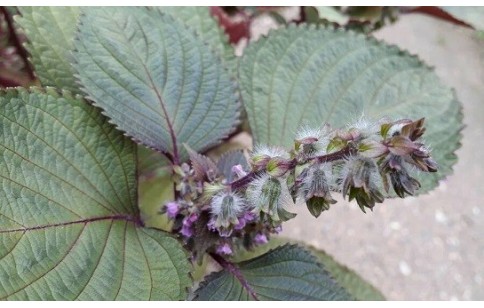- Code : #7201 A 1 g
- Formula : C₂₀H₂₇NO₁₁
- CAS : 29883-15-6
Perilla frutescens
Perilla frutescens, “Deulkkae”, “Perilla” or “Korean Perilla” in English, “Pérille” in French, belongs to the Lamiaceae botanical family. Native to East Asia, growing in waste areas and cultivated in gardens, it is an aromatic herb growing to 0.9 m, widely cultivated as an edible plant for humans (it is toxic to cattle and horses).
Leaves, seedlings and seeds all have culinary as well as medicinal uses. The leaves are used in the treatment of colds, chest stuffiness, vomiting, abdominal pain etc. The juice of the leaves is applied to cuts and wounds. The seed is used internally in the treatment of asthma, colds and chills, nausea, abdominal pain, food poisoning and allergic reactions (especially from seafood), bronchitis and constipation. The stems are a traditional Chinese remedy for morning sickness
271 natural molecules have been identified in perilla organs including phenolic acids, flavonoids, essential oils, triterpenes, carotenoids, phytosterols, fatty acids, tocopherols, and policosanols. Also rosmarinic acid, scutellarein, luteolin, apigenin, corosolic and tormentic acid.

- Code : #1102 S 20 mg
- Formula : C₁₅H₁₀O₅
- CAS : 520-36-5
- Code : #6034 S 20 mg
- Formula : C₉H₈O₄
- CAS : 331-39-5
- Code : #5014 S 100 mg
- Formula : C₁₅H₂₄
- CAS : 87-44-5
- Code : #0976 S 20 mg
- Formula : C₁₅H₁₄O₆
- CAS : 154-23-4
- Code : #2318 S 10 mg
- Formula : C₃₀H₄₈O₄
- CAS : 4547-24-4
- Code : #0932 S 20 mg
- Formula : C₂₇H₃₁O₁₆Cl
- CAS : 2611-67-8
- Code : #4753 S 20 mg
- Formula : C₁₀H₁₀O₄
- CAS : 537-98-4
- Code : #1124 S 20 mg
- Formula : C₁₅H₁₀O₆
- CAS : 520-18-3
- Code : #5082 S 100 mg
- Formula : C₁₀H₁₆
- CAS : 5989-27-5
- Code : #1125 S 20 mg
- Formula : C₁₅H₁₀O₆
- CAS : 491-70-3
- Code : #1135 S 20 mg
- Formula : C₁₅H₁₀O₇,2H₂O
- CAS : 6151-25-3
- Code : #4957 S 20 mg
- Formula : C₁₈H₁₆O₈
- CAS : 20283-92-5
- Code : #1405 S 10 mg
- Formula : C₂₁H₁₈O₁₂
- CAS : 27740-01-8















